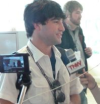Cold Email All Stars {Quick Advice from Sales Leaders}
Cold Email All Stars {Quick Advice from Sales Leaders}:
from (title unknown)

Approaching a prospective client out of the blue isn’t as simple as it seems. So we talked to the three “renaissance painters” we know regarding the cold email.
Let’s see what they had to say:

Jon Birdsong is the CEO of Rivalry, a sales process management company in Atlanta, GA.
Scott Britton does Business Development at SinglePlatform, a company that helps local businesses get their digital menu in front of consumers on the search sites and mobile apps that matter mostThe perfect cold email contains charm, confidence, eccentricity, intelligence, pressure, creativity and patience.
Let’s explore.
The Title – Absolutely the most important part of the email. If this doesn’t prompt a recipient to open your email then all is lost.
What Prompts a Recipient to Open – Many sales reps wrongly try to jam too much in to the email title. Whether it’s cramming their value prop in 3 words or explaining a feature in 4 words, the best titles are the ones that get opened and from my experience, it requires a simple concept: familiarity.
Find the familiarity — just enough so they’ll open it. It could be the mascot of their Division 3 alma-mater or a response to their latest tweet. One example I recently used: after researching the individual on LinkedIn, he had a picture of the 13th hole at Augusta National Golf Club. So I titled the email, “13th hole at Augusta National” — we had a call two days later.
The Body: Assuming the recipient opened the email, now is the time to use your charm and craft.
Also address the recipient by their first name.
Sentence number one: The first sentence should be the “icebreaker.” The goal of the ice breaker should focus getting the recipient’s mind away from the “who the heck is this damn stranger emailing me” mentality. Use charm, humor, wit, or bravado and directness to break the ice. A great sales rep can tell through the digital footprints what’s the best approach for each recipient.
Sentence number two: The simple ask. The ask in a cold email is never for more than a 10 minute call — even Warren Buffet has 10 minutes to hear something potentially valuable to his organization. Keep the ask broad and generic. Focus on the mutual industry: sales, marketing, HR, etc.
Sentence three: Show gratitude for them reading this far and consideration to meet.
The Sign Off: End with Best, Sincerely, Respectfully, or more. Feel free to put a blog post or catchy title in the “P.s.” This is where you can really “sell them” if you feel inclined.
1. The most important action once someone has opened up an email is to get them to read it.
Thus, the goal of the first sentence is to get them to read the second sentence. The goal of the second sentence is to compel them to read the third and so on. It doesn’t matter how amazing your call to action is in the fifth sentence if no one ever makes it that far, which is why understanding this component is so important.
2. I’ve found using copy and a tone within a cold email that’s conversational vs. rigid yields the optimal response rate. I hypothesize this is because:
If you’re interested in more sales and business development strategies on cold emailing, you can check out “The Approach and Getting A Meeting” section of this comprehensive resource on startup business development.
- Taking this approach assumes familiarity vs. this person doesn’t know me
- This is a stark contrast to spammers who cold email
- People like doing business with people they like. You come off as more likeable using this approach

Adam Wexler is a social media expert and founder of Insightpool, a resource for social automation software.
–Keep it short and sweet.
Make sure the opening email is three sentences or less. Start it with a friendly opening (e.g. hope you’re doing well). The second sentence could be dedicated towards a quick description of your company or why you’re writing, but you’re often better off just getting to ‘the ask.’
Make sure the question is easily digestible. As David Allen could tell you, if it will take over two minutes to answer, busy people will push it off and likely never get back. Ideally, make it a ‘yes’ or ‘no’ question with the ability for them to describe why they said either of those. Only at the end do I craft my subject, and I often try to make it something ambiguous that will ensure they open the email at the least.
More than anything though, the majority of replies will often come from the followup (but that’s a story worthy of another blog post, right?)
We were inspired by these experts to create some tips of our own:
1. Personalize
The last email your prospect wants to read is a generic one. Find out the basic information about your prospect. How did you hear of them and why do they interest you? That is a question you should be able to answer in the beginning of the email. Take it a step further- if they have a blog, read it and tell them what you thought of a post. There is a world of data out there for you to find out about your client, so utilize it.
2. Be concise
Assume your prospective client is very busy. They don’t have time to read a long email- if anything it will deter them from wanting to finish the email and will encourage them to press the “delete” button. Be brief and to the point. Send them something they can read on their phone or in the hurried moments they get to check their email on their computer between meetings.
3. Call to Action
Be specific- what do you want the client to do after they read your email? Establish what the next step is. Asking a specific question such as “Are you available to talk next week?” is a better chance of getting a response from your prospect than “I hope to hear from you.”
We’d love to hear your tips about the cold email. Comment below!


No comments:
Post a Comment